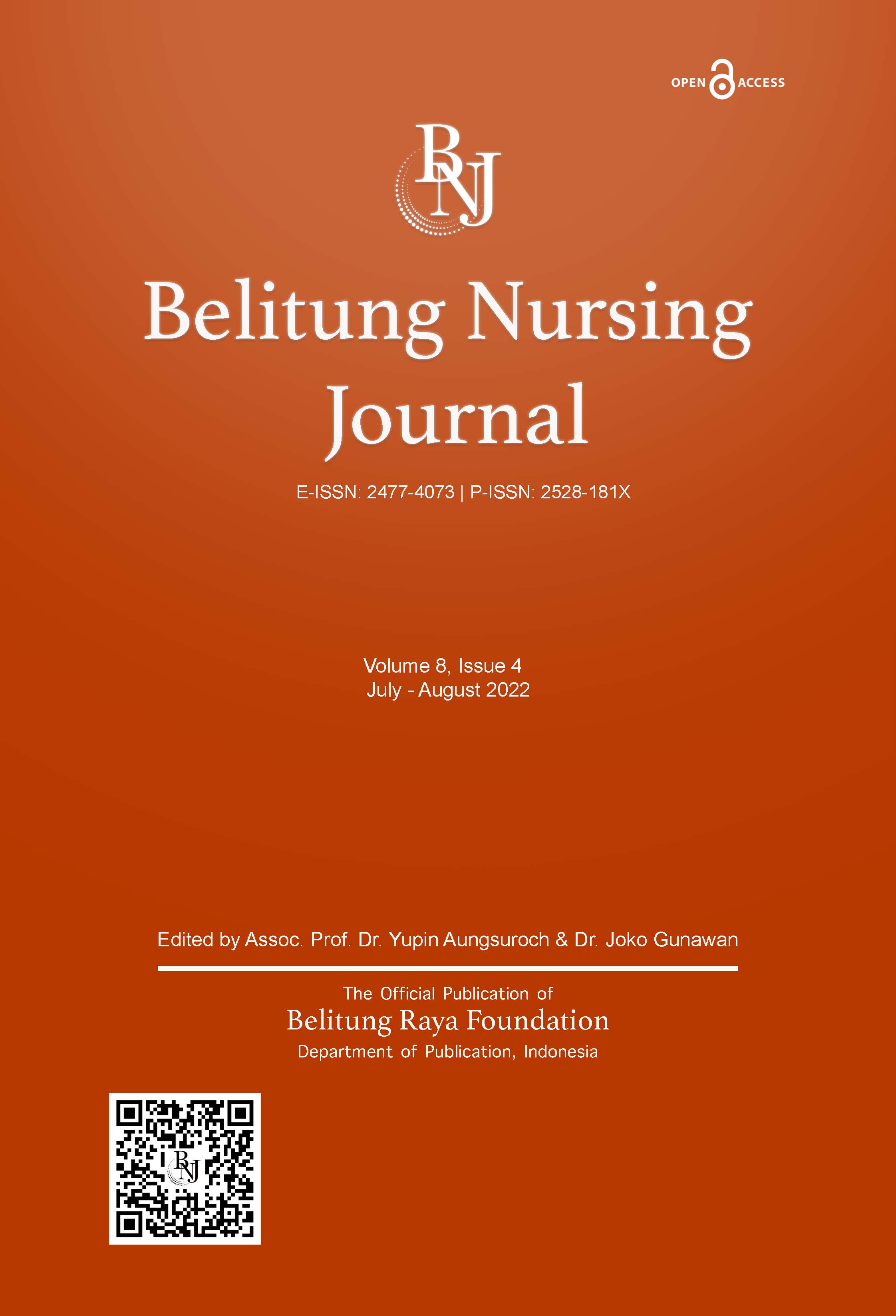Background
In the Sustainable Development Goals (SDGs), maternal mortality rates need to be reduced to 70 per 100,000 live births by 2030. The World Health Organization (WHO) reports that the global mortality rate reached 289,000 deaths. There were 9,300 inhabitants in the United States, 79,000 in Africa North, and 16,000 in Southeast Asia (WHO, 2014). The mortality rates in developing countries reached 230 deaths per 100,000 live births. They contribute up to 99% of maternal deaths globally. Hence, these health problems need special attention in all countries, including Indonesia (WHO, 2014).
Developing countries face maternal mortality due to pregnancy matters such as direct obstetric complications, including bleeding, sepsis, gestational hypertension, obstruction and prolonged labor, and unsafe abortion. Other indirect causes of the conditions involve malaria, HIV/AIDS, and heart disease. In addition, hemorrhage and hypertension are the leading causes of the highest maternal deaths in South Asia and Sub-Saharan Africa. Meanwhile, some direct causes of maternal mortality in developed countries are complications of anesthesia and cesarean section. Thus, this discrepancy reflects a global disparity in access to obstetric care (Donnay, 2008).
Using maternal delivery in health facilities may reduce maternal mortality in Indonesia. Delivery carried out in a health facility can ensure the mother’s safety. Health facilities have better standard operating procedures and health workers with guaranteed expertise. Meanwhile, in non-health facilities, there is no guarantee of skilled health workers; otherwise, only traditional birth attendants without licenses handle the delivery process (Ministry of Health, 2017). Andersen’s theory groups some determinants in the utilization of health services into three main categories, namely: 1) predisposing characteristics (demography, gender, age, marital status, social structure, education, occupation, hobby, race, religion, and health belief), 2) enabling characteristics (family resources and community resources), and 3) needs characteristics (individual and clinical assessment) (Andersen & Newman, 1973).
Previous studies have explored factors influencing the choice of delivery place. For example, a cross-sectional survey in Jimma city, one of the largest in Ethiopia, has found age groups, education levels, religion, antenatal history, and parity are significantly related to the choice of birthplaces (Yegezu & Kitila, 2015). Research conducted in Nigeria shows a relationship between age groups, occupation, education, income, and marital status in choosing delivery places in health facilities (Envuladu et al., 2013). In addition, a study conducted by Dickson et al. (2016) reports that economic status, ethnicity, maternal education, ecological zones, parity, and distance to the facility become determinants of maternity site selection. Research by Abdulmageed and Elnimeiri (2018) shows age, area of residence, number of children, financial income, education, distance to health facilities, and source of decisions on birthplace are significant determinants for women to determine birthplace. However, a study in six African countries revealed that maternal and infant mortality and morbidity could be lower when mothers choose health facilities as a delivery place with the assistance of skilled medical personnel. The use of health facilities has been proven to have a positive relationship with a strong community level. In addition to having skilled health workers, health facilities also have advanced medical equipment; officers always keep equipment sterile so that it is safe and ready to use. Also, they have a comfortable place to give birth purposefully established for maternity (Stephenson et al., 2006). Skilled personnel in health facilities also may improve the primary goal of delivery safety (Kesterton et al., 2010).
As a middle-income country, Indonesia has 262 million residents from 300 ethnic groups with 730 languages spoken across 17,774 islands (Agustina et al., 2019). It has a large rural population in ASEAN (Khor, 2008). The older population occupies rural areas more than urban areas (Utomo et al., 2019). Improving the health care quality in rural areas is a formidable task affecting residents’ access to emergency care. Access to healthcare services may be hampered by the shortage of available resources, the lack of public transport, and distances to primary healthcare centers in rural areas. The absence of health science libraries and tertiary care facilities poses a challenge for providers to upgrade officers’ knowledge. It also threatens health status and the accessibility of quality health care in all communities (Merwin et al., 2006). Many factors inhibit access to health services in rural areas. Some may include geographic isolation, transportation, economic instability, shortage of providers, discontinuation or fragmentation of care, stigma, funding losses, poor education concerning preventive measures, limited resources, and ethical challenges (Brems et al., 2006).
Research on the determinants of delivery place in Indonesia is essential, especially in rural areas. The gap in the availability of health facilities in urban and rural areas is high, but little research on this topic is still yet to be explored. Understanding the prevalence and predictors for the choice of delivery place will affect policy formulation and intervention strategies. Therefore, this study aimed to analyze determinants of the choice of delivery place in rural Indonesia.
Methods
Study Design
A cross-sectional quantitative study was conducted by analyzing the secondary data from the IFLS-5 Indonesia Family Life Survey in 2014.
Samples/Participants
IFLS was selected through multistage random sampling, where 321 random enumeration areas from 13 provinces were chosen. The provinces selected based on cost efficiency include four Sumatera provinces (North Sumatera, West Sumatera, Lampung, and South Sumatera), five Java provinces (DKI Jakarta, Central Java, West Java, East Java, and DI Yogyakarta), and four provinces including major island groups (South Sulawesi, Bali, South Kalimantan, and West Nusa Tenggara) (Strauss et al., 2016). The participants included in this study were 2,389 female respondents who had given birth in rural areas and were aged 15-49 years.
Instruments
This study employed a questionnaire from the IFLS-5 Indonesia Family Life Survey, which can be accessed free on the website: http://www.rand.org/labor/FLS/IFLS/download.html. The dependent variable in this study was the delivery place, which is the place where mothers seek and get maternity and delivery services and assistance. The choice of delivery place is divided into two: health facilities (including hospitals and primary health care centers), village maternity posts, clinics, midwife practices, and non-health facilities (including one's own home, family home, and traditional birthplace).
While the independent variables include: 1) Education variable, the latest education level followed/completed by the respondents. It is divided into three: primary (elementary school and below), secondary (junior high school, high school), tertiary (diploma, college); 2) Region, the province where the respondents reside, and it is divided into three islands: Sumatera, Java/Bali, and the eastern region; 3) Economic status, proxy by the total household expenditure for staple food consumption and non-food costs (health, taxes, clothing, etc.). After enumerated, it is then categorized into five groups: 20% (very poor/Q1), 21-40% (poor/Q2), 41-60% (middle/Q3), 61-80% (rich/Q4), above 80% (wealthy/Q5); 4) Insurance ownership, insurance owned by the respondents for using health services. It is categorized into no health insurance and having health insurance; 5) Mother's job status, consisting of work and not-work categories; 6) History of Antenatal Care (ANC), minimally counts for four times during trimester I-III. The variable is grouped into two: complete (> = 4) and incomplete (<= 3).
Data Analysis
This study used SPSS version 23 to conduct univariate and bivariate analyses (frequencies and cross-tabulations). In addition, logistic regression statistical tests were used to analyze factors associated with the choice of delivery place in rural Indonesia.
Ethical Consideration
The data from the IFLS-5 survey have been approved by Ethics Review Board at Gadjah Mada University, Indonesia.
Results
As shown in Table 1, 67% of the respondents delivered in health facilities. In addition, the majority of respondents had secondary education (53.1%), lived in Java/Bali regions (64.1%), had health insurance (55.9%), and had a complete antenatal care visit (63%). However, half were unemployed (54%), and some were from impoverished economic groups (35%).
| Variables | n | % |
|---|---|---|
| Place of delivery | ||
| Health facilities | 1,600 | 67.0 |
| Non-health facilities | 789 | 33.0 |
| Education | ||
| Tertiary | 227 | 9.5 |
| Secondary | 1,268 | 53.1 |
| Primary | 894 | 37.4 |
| Region | ||
| Sumatera | 551 | 23.1 |
| Java/Bali | 1,532 | 64.1 |
| East region | 306 | 12.8 |
| Economic status | ||
| Very rich | 209 | 8.7 |
| Rich | 285 | 11.9 |
| Middle | 462 | 19.3 |
| Poor | 598 | 25.0 |
| Very poor | 835 | 35.0 |
| Insurance ownership | ||
| Yes | 1,336 | 55.9 |
| No | 1,053 | 44.1 |
| Job-status | ||
| Work | 1,098 | 46.0 |
| No work | 1,291 | 54.0 |
| History of antenatal care | ||
| Complete | 1,505 | 63.0 |
| Incomplete | 883 | 37.0 |
Table 2 shows that the most influential variable seen from the highest adjusted prevalence ratio value was education (PR = 4.559; 95% CI = 3.751-5.542). Higher education had a 4.5 times greater effect on people getting delivered in health facilities after controlling other variables.
| Variables | p-values | Prevalence Ratio (PR) (95% CI) |
|---|---|---|
| Education | ||
| Tertiary | 0.000 | 4.559 (3.751-5.542) |
| Secondary | 0.000 | 2.312 (1.958-2.729) |
| Primary | Ref | |
| Region | ||
| Sumatera | 0.054 | 1.322 (0.995-1.758) |
| Java/Bali | 0.000 | 3.400 (2.994-3.862) |
| East Region | Ref | |
| Economic status | ||
| Very rich | 0.037 | 1.220 (1.012-1.1470) |
| Rich | 0.549 | 0.951 (0.806-1.123) |
| Middle | 0.053 | 1.191 (0.998-1.421) |
| Poor | 0.001 | 1.308 (1.129-1.516) |
| Very poor | Ref | |
| Insurance ownership | ||
| Yes | 0.001 | 0.785 (0.698-0.882) |
| No | Ref | |
| Job status | ||
| Work | 0.001 | 1.272 (1.145-1.413) |
| Not work | Ref | |
Discussion
The purpose of this study was to analyze determinants of the choice of delivery place in Indonesia. The analysis showed that most respondents gave birth in a health care facility in rural areas. In addition, this study reported the respondents with a higher education performed delivery in health facilities the most. It is consistent with a previous study that proved that most women who deliver in health facilities have a secondary education level and higher (Ganle et al., 2014).
Women's education status, therefore, was the most significant factor influencing the choice of delivery place. Women with secondary or higher education are more likely to use childbirth services in health facilities. Studies conducted in six African countries conclude that secondary or higher education leads to greater awareness of women choosing health facilities as a place of delivery. Women's education level can indicate an understanding of the importance of a safe and comfortable setting for maternal and child health. The higher the education level, the more confident to utilize health facility services (Stephenson et al., 2006). Previous studies also believe educational variables have a significant relationship with the utilization of health facilities for delivery (Abdulmageed & Elnimeiri, 2018; Dickson et al., 2016; Envuladu et al., 2013; Kitui et al., 2013; Rahman et al., 2008)
The study respondents in Java and Bali had the highest priority in selecting health facilities as delivery places. It can be assumed that the availability of infrastructure in Java and Bali is more adequate than in other regions. It is in line with research conducted in Tanzania, where the use of health services varies across areas (Bishanga et al., 2018). The analysis showed a relationship between the region and the use of delivery places. Stakeholders must consider the differences when formulating policies and designing programs to increase health facilities’ labor rates. The differences may include quality of care, labor and facility density, and availability of essential commodities in health facilities (Bishanga et al., 2018).
In addition, economic status had a relationship with the choice of delivery place. Mothers with a high-economy level were more likely to choose health facilities compared to non-health facilities. Economic status is a supporting and reinforcing factor in access to health services, i.e., costs for health services. Those from lower economic families will have less ability to use maternity health facilities. Maternity at home is an alternative for mothers to meet childbirth needs within limited costs. Traditional birth attendants provide cheaper services; thus, mothers with lower economic status prefer non-health facilities for delivery. The wealth index is useful for determining socioeconomic status in a household. Research by Kitui et al. (2013) shows a significant relationship between economic status and maternity service choice. Poverty reduces affordability to bear services, and thus women in rural areas tend to choose cheaper home delivery services. Other research also shows that the higher the wealth index or economic status drives someone to select a health facility (Envuladu et al., 2013; Stephenson et al., 2006)
Another variable is health insurance ownership, which was related to the use of a health facility. This aligns with Kitui et al. (2013) showed that respondents who do not give insurance tend to have the opportunity to give birth at home or in non-health facilities. In other words, insurance has a significant relationship with the utilization of health services (Rahman et al., 2008). In this case, it can be said that mothers who have insurance have the opportunity to more easily access the place of delivery in health facilities than those who do not have insurance (Gouda et al., 2016; Hwang et al., 2017; Kitui et al., 2013).
Furthermore, employment was related to the choice of health facilities for delivery. Work allows ones to access the outside world. Therefore, one will make better decisions once they are employed. Conversely, mothers who do not work do not deliver in health facilities but at home (Envuladu et al., 2013). Employment is another socioeconomic factor significantly affecting health care utilization. Employment is an economic resource that empowers women to take responsibility for their health and facilitates easy access to quality care. Previous research also found a similar finding (Kalu & Martha, 2017). Another study explains that women's position in households is another factor that can influence decisions on whether or not to use delivery services in health facilities. Independent women are more likely to use health services than those who rely on family members or husbands (Ewa et al., 2012). Meanwhile, research conducted in Kenya finds that respondents who were not working or were homemakers were six times more likely to give birth at home than those employed (Ogolla, 2015).
Unemployed mothers may choose to give birth in a health facility because they tend to depend on the decision of a companion/partner and encouragement from influential people, such as parents or in-laws. The closest person may recommend what they need to experience. Health service utilization was not a significant predictor among hypertensive patients in Korea. Besides, empirical evidence was lacking on whether different occupational groups use hospitals (Ham & Lee, 2007).
The history of antenatal care visits is another factor associated with delivery in a health facility. A study among pregnant women in Ghana shows that women with at least four antenatal care visits tend to deliver in health facilities (Nketiah-Amponsah & Sagoe-Moses, 2009) because antenatal care determines the use of health facilities (Kitui et al., 2013; Yegezu & Kitila, 2015). In addition, the more frequent antenatal care visits, the higher health promotion is needed (Egharevba et al., 2017).
Health services work only if professional health workers are present in Indonesian areas in rural and remote areas. Expansion of services also requires the role of nurses. In isolated and remote regions, nurses tend to take on extended practice roles to fill the gaps caused by the shortage of medical professionals. However, this expanded role is not always legitimized, and the need for continuing education is greater (Greiner et al., 2008). While some studies suggest that redistribution of duties to nurses is appropriate, this is not based solely on personnel availability or cost considerations (Crossan & Ferguson, 2005).
Limitations
This study is less able to track the causality between factors as it uses a cross-sectional survey design. However, from the secondary data analysis, some variables were related to the choice of delivery place, including education, economic status, marital status, employment, ANC visits, insurance ownership, regional location, and region. Due to data limitations, there were still variables not included in this study, such as maternal parity and distance to health care facilities. Thus, further studies to cover all factors will be beneficial in determining the choice of delivery place.
Implications
Mothers who gave birth in health facilities in rural were at 67%. The Government of Indonesia is suggested to increase this number to improve the maternal and infant health outcomes by strengthening the provision of health infrastructure, especially in rural areas. It is due to geographical constraints being considered a barrier to access to health facilities. In addition, healthcare workers should be expanded or distributed to remote and rural areas to provide maternal services. However, equitable health development is a supporting factor for better maternal health services. Also, the government is recommended to pay attention to economic status, insurance ownership, and job status among the mothers in rural areas. In addition, this study serves as an input for the healthcare professionals, especially nurses and midwives, to continually improve mothers’ education regarding the delivery choices.
Conclusion
This study aimed to analyze determinants of the choice of delivery place in rural Indonesia. Mothers with higher education had a greater tendency to give birth in health facilities than mothers with low education. Therefore, the government and healthcare professionals, particularly nurses and midwives, should improve mothers’ education and provide educational facilities through direct communication, information, and media education. In addition, the other factors, such as region, economic status, insurance ownership, and job status, should be considered to improve strategies to increase maternal health outcomes in Indonesia.









